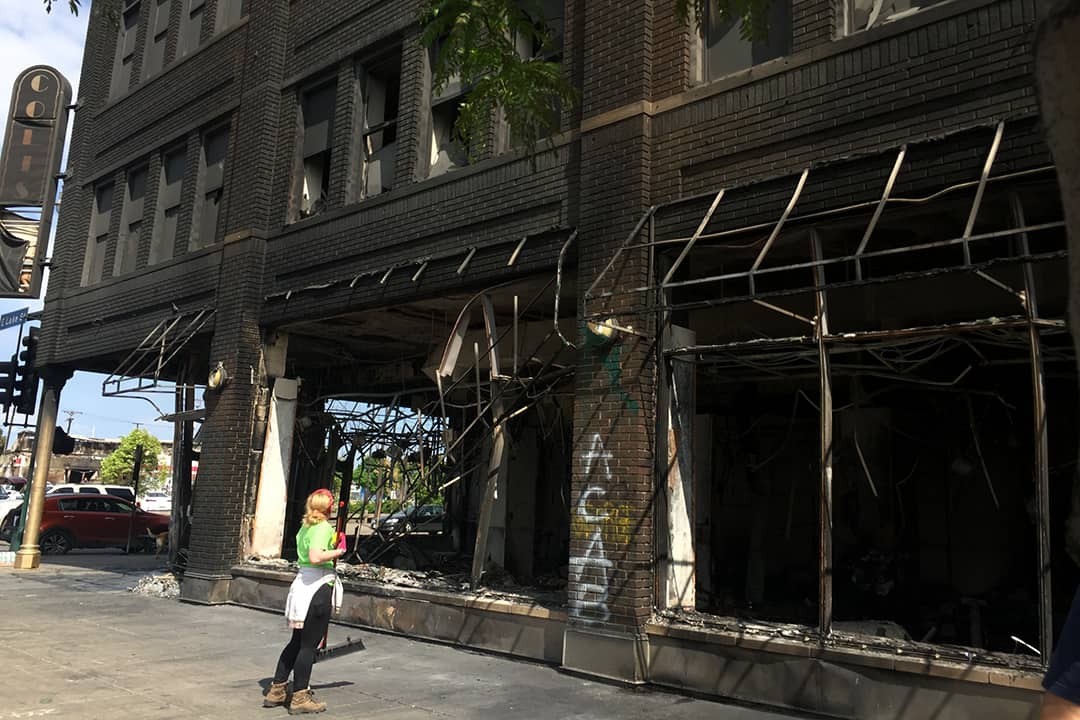“Let my building burn; justice needs to be served.”
This is what Ruhel Islam, the owner of the popular Gandhi Mahal Restaurant in Minneapolis, said when he learned that the small business he dedicated his life to was burning to the ground in the midst of the massive uprising in Minneapolis.
The restaurant’s location at the intersection of East Lake Street and Minnehaha Avenue, deemed by some to be the heart of South Minneapolis, is now virtually unrecognizable. The sounds of still-smouldering pieces of rubble echo as they fall into deep pits — the remnants of former restaurants and liquor stores. Melting glass stains the sidewalks an inky yellow.
One might feel a sense of desolation looking at those charred, empty buildings, but it is nothing compared to the anger and desperation that still lingers less than five kilometres away at the place where it all began: the intersection of East 38th Street and Chicago Avenue. It was there that, on May 25, Officer Derek Chauvin knelt on the neck of George Floyd for eight minutes and 46 seconds — killing him — over a supposedly counterfeit $20 bill.
This act of police brutality was the deliberate execution of a Black man by a white cop — a scene that has played out countless times in America. The United States is a country founded on principles of liberty, freedom, and justice for all — but it is also a country that has systematically denied those very rights to its Black citizens, even before the constitution that entrenched those ideals was signed.
Racism in ostensibly ‘liberal’ US cities like Minneapolis is nothing new — discriminatory redlining of Minneapolis neighbourhoods became prominent in the early twentieth century. Homeowners and realtors alike refused to sell homes to Black people, reproducing centuries-old sentiments of white supremacy.
During this period, racial housing covenants were written into deeds, effectively barring Black people from occupying established white areas. They were then forced into regions like Near North Minneapolis, which remains majority Black to this day.
According to a study conducted from 2013–2017 by the US Census Bureau, only 24 per cent of Black households owned their homes, compared to a staggering 76 per cent of white households. The US Census Bureau also noted other prominent disparities in education, income, and unemployment rates between the two groups.
While these statistics seem too large to ignore, the majority of white people in Minneapolis have had, and continue to have, the privilege to do just that. And this includes me: I have lived in Minneapolis my whole life. I frequently went to Cup Foods, the store in front of which Floyd was murdered, for a snack and a pop on hot summer days. My high school was a little over five blocks away from East Lake Street and Minnehaha Avenue, where the Gandhi Mahal Restaurant and the now-decimated Minneapolis 3rd Police Precinct lies.
For my whole life, I have lived comfortably with the simplistic notion that my city was a liberal haven — a city that had transcended race. The media called us progressive and lauded our diverse figureheads, and we accepted their praise as fact — as if to say, “See? I can’t be racist. I live here.”
This forced narrative of diversity, inclusion, and multiculturalism is a means of avoiding the true history of Minneapolis: a city designed to lock Black people out. So, what does this all have to do with the current situation? Everything.
In Minneapolis, police officers use force in encounters with Black people at least seven times more often than they do with white people. In the past five years, our community has seen Jamar Clark, Thurman Blevins, Philando Castile, and now Floyd killed at the hands of police.
Black folks have been denied equal access to almost everything that white Minneapolitans like myself often take for granted — good schools, trust in law enforcement, and more. The immense pressure of these inequalities has been building, and building, and building for generations. It has finally reached its breaking point.
So, when white people complain about the rioting, looting, and burning, they often forget that this is not a mere cry of frustration from the Black community. It is the long, mournful, thundering howl of a revolution, centuries in the making.
It is also important to remember that other communities have achieved civil rights in the exact same way: by rioting, looting, and burning. Americans often forget that many of the liberties that we enjoy today are a direct result of such disobedience. Corporations everywhere are slapping the pride flag on their logos and products this month — a direct legacy of the Stonewall Riots that were violent, illegal, and started by Black and transgender activists.
Let them be angry. Let them be as vocal or as quiet as they like. Donate money or supplies. Amplify their voices with our platforms and our privilege, and call out other white people and non-Black racialized communities for their racism. Keep reminding people that the movement is far from finished. Keep saying that Black lives matter.
This may just be another battle in the long war against police brutality, but we can only succeed if we keep on fighting. We need to protest for our future, so that we won’t repeat our past
Ruhel Islam, perhaps unknowingly, made a revolutionary point in one short statement. If letting our businesses burn finally communicates to the world Minneapolis’ vital need for the total reconstruction of our justice system, then let it happen. Let our city burn.
Maia Roberts is a second-year environmental science, environmental biology, and Spanish student at Victoria College. She is a member of the Young People’s Action Coalition in Minneapolis.
Editor’s Note (June 8, 3:21 am): This article has been modified to reflect the author’s originally intended audience with regard to providing support to Black communities. The description of the audience was altered during the editing process. The Varsity regrets the error.


